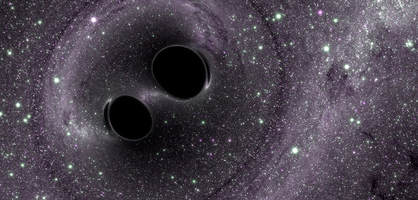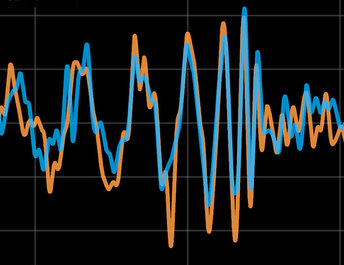|
It was expected, is was a loud secret, but it is well deserved prize. The detection and verification of the Gravitational Waves predicted by Einstein in 2016 has been awarded with the Physics Nobel prize 2017.  Science might look less exciting in real life than in movies, as there everything is so fast, so stressful, that it seems that you only need seconds to revolutionize life. But that is far from truth. I remember studying General Relativity in my last year in college. It was one of the courses that I most enjoyed, time dilation, gravitational pull that distorts space and time, black holes, cosmology. Gravitational waves, GW, was one chapter that I did not expect, I though that was going to be a rough mathematical one with minor implications. But it wasn't. It was surprising to imagine that we could see beyond light by using GW. Indeed, in the final project that I had to do in that course I was asked to figure out a way to detect them. I related that to the solid state course that I was taking at the same time. But I was off by several orders of magnitude. At that time the LIGO project was a baby just newborn.  The discovery of GW is not just one more of hundreds of demonstrations that Einstein's General Relativity works (I'd say rules), but it is the opening of new eyes to the Universe. I was socked when the first announcement of their detection on Earth, I was waiting for the LISA project. The LIGO experiment, that triangulates with three detectors now (two in the U.S. and one in Italy) is able to see were the light can't reach. It is able to study phenomena that can't otherwise be studied. It is the opening of a new astronomy, and I am proud and happy that Carleton College has contributed to that achievement. Next Monday October 16th LIGO will make a new announcement, probably detection of neutron star merger? We better stay tuned. Here and here you can find the last of the publications of the LIGO team on September 2017.
36 Comments
11/9/2022 19:51:22
Really informative article, I had the opportunity to learn a lot, thank you. https://kurma.website/
Reply
12/9/2022 05:23:11
Really informative article, I had the opportunity to learn a lot, thank you. https://odemebozdurma.com/
Reply
14/9/2022 21:35:05
Really informative article, I had the opportunity to learn a lot, thank you. https://bit.ly/site-kurma
Reply
30/9/2022 14:39:28
It's great to have this type of content. Good luck with your spirit. Thank you. https://bit.ly/site-kurma
Reply
4/10/2022 18:54:32
I think this post is useful for people. It has been very useful for me. Looking forward to the next one, thank you. https://escortnova.com/escort-ilanlari/ankara-escort/polatli-escort/
Reply
5/10/2022 11:59:26
It was a post that I found very successful. Good luck to you. https://escortnova.com/escort-ilanlari/kocaeli-escort/basiskele-escort/
Reply
6/10/2022 04:03:00
I follow your posts closely. I can find it thanks to your reliable share. Thank you. https://escortnova.com/escort-ilanlari/erzurum-escort/
Reply
6/10/2022 16:46:24
I support your continuation of your posts. I will be happy as new posts come. Thank you. https://escortnova.com/escort-ilanlari/izmir-escort/selcuk-escort/
Reply
7/10/2022 07:26:10
I think the content is at a successful level. It adds enough information. Thank you. https://escortnova.com/escort-ilanlari/kayseri-escort/melikgazi-escort/
Reply
8/10/2022 03:18:23
Thank you for your sharing. I must say that I am successful in your content. https://escortnova.com/escort-ilanlari/istanbul-escort/bakirkoy-escort/
Reply
8/10/2022 15:15:51
Thoughtful and real content is shared. Thank you for these shares. https://escortnova.com/escort-ilanlari/bursa-escort/keles-escort/
Reply
21/11/2022 10:11:53
Tıkla evde calismaya basla: https://sites.google.com/view/evden-ek-is/
Reply
9/12/2022 10:18:07
Garantili Tiktok takipçi satın al: https://takipcialdim.com/tiktok-takipci-satin-al/
Reply
9/12/2022 10:20:37
instagram beğeni satın al: https://takipcialdim.com/instagram-begeni-satin-al/
Reply
15/12/2022 09:55:26
takipçi satın al ve sitemizi ziyaret et: https://takipcim.com.tr/
Reply
8/1/2023 16:03:43
100 tl deneme bonusu veren siteleri öğrenmek istiyorsan tıkla.
Reply
27/4/2023 21:13:58
Steroid Sipariş: https://www.anabolickapinda14.com/urun/
Reply
10/5/2023 14:59:00
Heets Çeşitlerine Göz At: https://bit.ly/heets-heets
Reply
30/6/2023 17:14:02
En iyi hakkari ilan sitesi burada. https://hakkari.escorthun.com/
Reply
9/8/2023 11:20:29
Steroid Siparis Steroid Fiyatlari Steroidler Anabolizan Orjinal Steroid Steroid Satis Steroid Satın Al Steroid Siparis Et
Reply
15/8/2023 06:17:30
https://www.sporunuyap8.com/ teşekkürler
Reply
Leave a Reply. |
Andrés AragonesesPhysicist, working in quantum optics and nonlinear dynamics in optical systems. Loves to communicate science. Archives
January 2018
Categories |
 RSS Feed
RSS Feed
